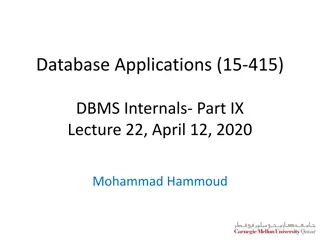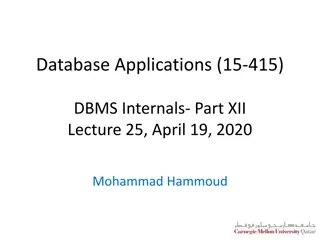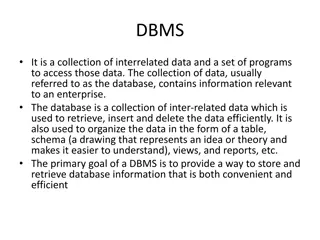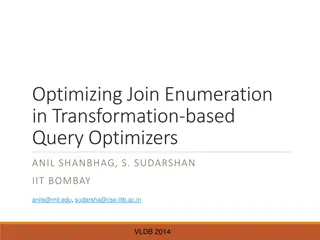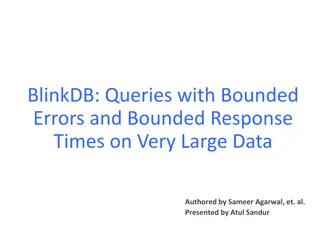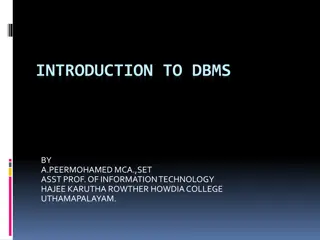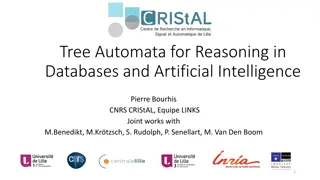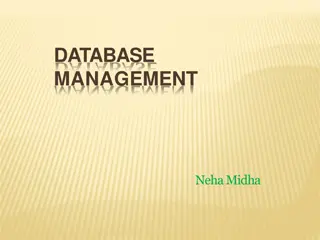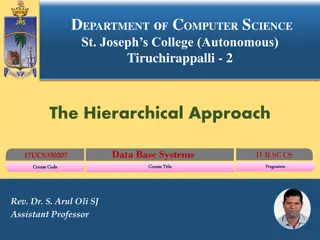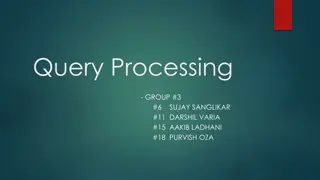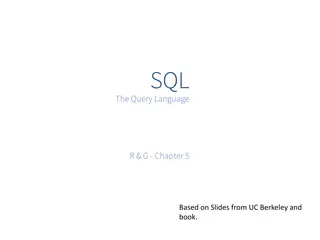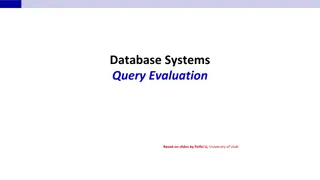Enhancing Query Optimization in Production: A Microsoft Journey
Explore Microsoft's innovative approach to query optimization in production environments, addressing challenges with general-purpose optimization and introducing specialized cloud-based optimizers. Learn about the implementation details, experiments conducted, and the solution proposed. Discover how
7 views • 27 slides
Query Optimization in Database Management Systems
This content covers the fundamentals of query optimization in Database Management Systems (DBMS), including steps involved, required information for evaluating queries, cost-based query sub-system, and the role of various components like query parser, optimizer, plan generator, and cost estimator. I
5 views • 51 slides
Transaction Management in DBMS
In this lecture, Mohammad Hammoud covers the key aspects of transaction management in database management systems (DBMS). Topics include locking protocols, anomaly avoidance, lock managers, and two-phase locking. The session delves into the rules, data structures, and processes involved in maintaini
8 views • 56 slides
Database Management Systems (DBMS)
A Database Management System (DBMS) is a crucial tool for organizing, storing, and managing data efficiently. It allows users to create, update, retrieve, and delete data effectively, ensuring data consistency and security. DBMS software like MySQL and Oracle provide interfaces for various database
6 views • 21 slides
Optimizing Join Enumeration in Transformation-based Query Optimizers
Query optimization plays a crucial role in improving database performance. This paper discusses techniques for optimizing join enumeration in transformation-based query optimizers, focusing on avoiding cross-products in join orders. It explores efficient algorithms for generating cross-product-free
2 views • 18 slides
Overview of BlinkDB: Query Optimization for Very Large Data
BlinkDB is a framework built on Apache Hive, designed to support interactive SQL-like aggregate queries over massive datasets. It creates and maintains samples from data for fast, approximate query answers, supporting various aggregate functions with error bounds. The architecture includes modules f
2 views • 26 slides
Database Management Systems (DBMS): A Comprehensive Overview
This comprehensive overview of Database Management Systems (DBMS) covers the definition, environment, advantages, limitations, and characteristics of data in a database. It delves into the hardware and software components, user roles, and benefits of using a DBMS. The content highlights the control
3 views • 25 slides
Automata for Query Optimization in Databases and AI
Explore the use of tree automata for reasoning, querying databases using logic languages, optimizing queries through relation algebra, and core problems in query optimization. Learn about data exchange on the web, inference of information from incomplete data, and the semantics of Datalog programs f
3 views • 44 slides
Stream Processing in DBMS
In a database management system (DBMS), managing input streams efficiently is crucial for processing queries such as ad-hoc and standing queries. Techniques for handling input streams include stream management, calculating critical values, and mining query streams for insights. This process involves
3 views • 31 slides
Converting Logical Query Plans to Physical Query Plans in DBMS
Illustrations and steps involved in the process of converting logical query plans (LQP) to physical query plans (PQP) in database management systems (DBMS), focusing on optimization, algorithm implementation, and handling security issues. The images provide a visual guide to constructing physical qu
2 views • 36 slides
Report Writers Meeting with Query Performance Tips
A meeting was held on 12/08/2015 with Gary Yates to discuss query performance tips for report writers. The session covered important aspects such as retrieving necessary fields, using single list views or crosstabs effectively, and keeping query calculations simple. Additionally, insights on partiti
0 views • 14 slides
Introduction to Database Management Systems
Fundamentals and applications of Database Management Systems (DBMS) and SQL. Learn how DBMS helps in organizing and accessing data efficiently to avoid redundancy, inconsistency, and security issues. Understand the relational model and its attributes, and discover the importance of using DBMS for va
0 views • 61 slides
Efficient Query Execution on Raw Data Files
This research explores NoDB, a database system designed to eliminate the bottleneck of data-to-query time by querying raw data files in their original location. By redesigning the query processing layer to query raw data in situ state while automatically creating auxiliary structures, NoDB aims to m
0 views • 34 slides
Relational Database Query Execution
In the world of relational databases, query execution is a crucial process involving steps like compilation, optimization, and physical plan generation. This involves converting SQL queries into logical query plans, selecting algorithms, and optimizing operations for efficient performance. Different
4 views • 9 slides
Data Integration with Dependent Sources: Query Answering System
An exploration of a system called IDS for integrating dependent sources in data processing. The paper addresses theoretical challenges, focusing on query answering with dependent sources. Investigates source selection, computation, coverage, configuration, cost, and more. Proposes solutions for choo
2 views • 36 slides
Database Management Systems
Database management systems (DBMS) are crucial for storing and retrieving large amounts of data efficiently. DBMS optimizes data storage, ensures fast retrieval, and maintains data integrity through ACID properties. Metadata, data dictionaries, and system catalogs play essential roles in managing da
3 views • 46 slides
Databases and DBMS in Modern Systems
Explore the fundamental concepts of databases and Database Management Systems (DBMS) in the digital era. Learn about the structure of databases, the role of DBMS in managing data efficiently and securely, and real-world applications like banking systems. Discover the significance of multi-user acces
5 views • 42 slides
Distributed DBMS Architecture
Explore the architecture of Distributed Database Management Systems (DBMS) including Peer-to-Peer Systems, Multidatabase System Architecture, and the components of a distributed DBMS. Learn about the physical and logical organization of data, user interfaces, query optimization, and data processors
3 views • 16 slides
Distributed Database Design and Query Processing Overview
This presentation covers various aspects of distributed database design, integration, semantic data control, query processing, optimization, transaction management, replication, parallel systems, object DBMS, and more. Explore query decomposition, localization, and optimization strategies, along wit
3 views • 18 slides
Efficient Query Processing Techniques in Database Systems
Explore the innovative approach of plan bouquets for robust query processing in databases, along with the challenges and solutions in declarative query execution. Dive into cost-based query optimization strategies to enhance SQL query performance significantly by selecting the most efficient executi
2 views • 51 slides
Database Management Systems Fundamentals
Explore the basics of Database Management Systems (DBMS) including definitions, functions, memory requirements, reasons to use DBMS, and the importance of studying databases. Learn about data models, levels of abstraction, and the relational model of data. Dive into concepts such as data independenc
4 views • 17 slides
Hierarchical vs. Relational Database Management Systems: A Comprehensive Overview
Explore the fundamental concepts of databases, including Hierarchical and Relational Database Management Systems. Understand the role of a Database Management System (DBMS) in storing and retrieving data efficiently. Delve into the history and evolution of DBMS, from its inception by Charles Bachman
0 views • 62 slides
DBMS: Functions and Duties in Database Systems
Dive into the core functionalities of Database Management Systems (DBMS), including preparing efficient algorithms for relational algebra operations, translating database programs, managing optimization, ensuring consistency, and enhancing security. Explore how DBMS processes queries, executes DDL a
2 views • 62 slides
Basics of Databases and DBMS
Explore the fundamentals of databases and Database Management Systems (DBMS) in this informative chapter. Learn about the advantages of DBMS, architecture, components, and the importance of data management. Discover different types of databases, such as relational and distributed, along with the rol
2 views • 22 slides
Logic Query Plan Optimization Techniques for Database Systems
Explore cost estimation for query plans, query optimization via logic and size, and improving logic plans using commutative and associative operators. Learn about efficient algorithms, optimizing logic laws, and proof techniques for optimizing database query performance.
1 views • 55 slides
Introduction to Database Management Systems by Ms. Bhumika A. Chandkar
Explore the world of Database Management Systems (DBMS) through the insightful presentation by Ms. Bhumika A. Chandkar from Deogiri College, Aurangabad. Learn about the basics of DBMS, including its definition, components, and applications, along with examples of database mini-worlds and relationshi
2 views • 27 slides
Exploring the Layers of Query Processing in Distributed Systems
Delve into the intricacies of query processing in distributed systems, covering topics such as types of query processors, optimization strategies, decision sites, network topology exploitation, and more. Learn about languages used in object DBMS, optimization timing, statistics, and the exploitation
1 views • 14 slides
Query-Driven Streaming Network Telemetry with Flexible Telemetry for Management
Explore the innovative Sonata project led by Jennifer Rexford and team, focusing on query-driven streaming network telemetry. Learn about the spark-like query language, query-driven collection and analysis, and compiling individual operators to enhance network management and security. Discover the p
0 views • 15 slides
Parameter Sniffing and Query Optimization
In this insightful content, Benjamin Nevarez explores the intricacies of parameter sniffing, the Query Optimizer, and various aspects of parameterization in SQL Server. Dive into the world of query plans, plan reuse, and the impact of parameter values on query performance. Gain a deeper understandin
0 views • 22 slides
Parameter Sniffing and Query Optimization
In this content, Benjamin Nevarez discusses the concepts of parameter sniffing, query optimization, and parameterization in SQL Server. He explains the purpose of the query optimizer and procedure cache, different types of parameterization, and provides examples of explicit and implicit parameteriza
0 views • 9 slides
Query Optimization and Algebraic Laws Overview
Explore the process of query optimization and the application of algebraic laws in database management. Understand query rewriting, cost estimation, and the algebraic laws governing database operations. Learn about scan operations, joins, and laws involving selections and projections. Dive into exam
2 views • 42 slides
Query Execution and Optimization in SQL: A Comprehensive Overview
Explore the intricacies of query execution, optimization, and relational operators in SQL. Learn how to query multiple relations effectively and understand the semantics and evaluation of SQL queries. Dive into join queries, group by operations, and eliminate duplicates for efficient SQL data retrie
2 views • 97 slides
Buffer Management Strategies in DBMS
Buffer management in a Database Management System (DBMS) is crucial for optimizing memory usage and enhancing system performance. This involves intelligently shuffling data between main memory and disk, maintaining a buffer pool, implementing page replacement policies, and ensuring efficient handlin
3 views • 38 slides
Query Processing in Database Systems: Understanding SQL Query Execution
Explore the fundamentals of query processing in database systems with a focus on SQL query evaluation. Learn about single-table queries, query optimization, execution, and executor architecture. Understand how to process basic queries and utilize distinct selections, ordering, and grouping for effic
1 views • 70 slides
Constructing Physical Query Plans for Database Systems
Learn the process of constructing physical query plans in database systems with efficient algorithms, relational algebra operations, logic laws, optimization techniques, and more. Dive into the optimization and security aspects involved in building physical query plans.
0 views • 24 slides
DBMS Internals: Query Optimization Strategies
In this lecture, we delve into the strategies and steps involved in query optimization within a Database Management System (DBMS). From parsing queries to evaluating query plans, the process is broken down systematically. Cost estimation, catalog inspection, and selecting the optimal query execution
4 views • 51 slides
Problem Solving and Optimization in Artificial Intelligence
Explore the concepts of optimization and convex optimization in artificial intelligence, covering a variety of topics such as search, satisfiability, combinatorial and continuous optimization, and more. Delve into the definition of optimization problems, feasible regions, optimization objectives, an
1 views • 36 slides
DBMS Internals and Query Optimization: Understanding Relational Algebra Equivalences
Delve into the world of DBMS internals and query optimization by exploring relational algebra equivalences. Learn how a relational query optimizer uses equivalences to identify equivalent expressions, allowing for efficient query processing in database applications.
0 views • 65 slides
Understanding the Significance of Query Logs in Various Fields
Explore the utility of query logs in diverse sectors such as Social Sciences, Medical & Health, Advertising & Marketing, and Law Enforcement. Understand search behavior trends, categorize queries, improve document scoring, enhance performance through query caching, and address privacy concerns in in
4 views • 8 slides
Distributed Database Design and Query Processing Overview
Explore the intricacies of distributed database design and query processing, covering topics such as database integration, semantic data control, distributed query optimization, multidatabase query processing, and more. Delve into the challenges and strategies for selecting the best query processing
0 views • 18 slides

